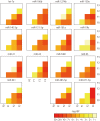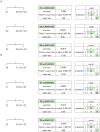Comprehensive miRNA expression analysis in peripheral blood can diagnose liver disease
- PMID: 23152743
- PMCID: PMC3485241
- DOI: 10.1371/journal.pone.0048366
Comprehensive miRNA expression analysis in peripheral blood can diagnose liver disease
Abstract
Background: miRNAs circulating in the blood in a cell-free form have been acknowledged for their potential as readily accessible disease markers. Presently, histological examination is the golden standard for diagnosing and grading liver disease, therefore non-invasive options are desirable. Here, we investigated if miRNA expression profile in exosome rich fractionated serum could be useful for determining the disease parameters in patients with chronic hepatitis C (CHC).
Methodology: Exosome rich fractionated RNA was extracted from the serum of 64 CHC and 24 controls with normal liver (NL). Extracted RNA was subjected to miRNA profiling by microarray and real-time qPCR analysis. The miRNA expression profiles from 4 chronic hepatitis B (CHB) and 12 non alcoholic steatohepatitis (NASH) patients were also established. The resulting miRNA expression was compared to the stage or grade of CHC determined by blood examination and histological inspection.
Principal findings: miRNAs implicated in chronic liver disease and inflammation showed expression profiles that differed from those in NL and varied among the types and grades of liver diseases. Using the expression patterns of nine miRNAs, we classified CHC and NL with 96.59% accuracy. Additionally, we could link miRNA expression pattern with liver fibrosis stage and grade of liver inflammation in CHC. In particular, the miRNA expression pattern for early fibrotic stage differed greatly from that observed in high inflammation grades.
Conclusions: We demonstrated that miRNA expression pattern in exosome rich fractionated serum shows a high potential as a biomarker for diagnosing the grade and stage of liver diseases.
Conflict of interest statement
Figures









Similar articles
-
Serum microRNA profiles in patients with chronic hepatitis B, chronic hepatitis C, primary biliary cirrhosis, autoimmune hepatitis, nonalcoholic steatohepatitis, or drug-induced liver injury.Clin Biochem. 2017 Dec;50(18):1034-1039. doi: 10.1016/j.clinbiochem.2017.08.010. Epub 2017 Aug 18. Clin Biochem. 2017. PMID: 28823616
-
Serum levels of microRNAs can specifically predict liver injury of chronic hepatitis B.World J Gastroenterol. 2012 Oct 7;18(37):5188-96. doi: 10.3748/wjg.v18.i37.5188. World J Gastroenterol. 2012. PMID: 23066312 Free PMC article.
-
Serum miRNA-27a and miRNA-18b as potential predictive biomarkers of hepatitis C virus-associated hepatocellular carcinoma.Mol Cell Biochem. 2018 Oct;447(1-2):125-136. doi: 10.1007/s11010-018-3298-8. Epub 2018 Feb 17. Mol Cell Biochem. 2018. PMID: 29455432 Clinical Trial.
-
miRNAs in patients with non-alcoholic fatty liver disease: A systematic review and meta-analysis.J Hepatol. 2018 Dec;69(6):1335-1348. doi: 10.1016/j.jhep.2018.08.008. Epub 2018 Aug 22. J Hepatol. 2018. PMID: 30142428
-
Efficacy of serum miRNA test as a non-invasive method to diagnose nonalcoholic steatohepatitis: a systematic review and meta-analysis.BMC Gastroenterol. 2020 Jun 12;20(1):186. doi: 10.1186/s12876-020-01334-8. BMC Gastroenterol. 2020. PMID: 32532204 Free PMC article.
Cited by
-
MicroRNAs in liver disease.Nat Rev Gastroenterol Hepatol. 2013 Sep;10(9):542-52. doi: 10.1038/nrgastro.2013.87. Epub 2013 May 21. Nat Rev Gastroenterol Hepatol. 2013. PMID: 23689081 Free PMC article. Review.
-
PCA-based unsupervised feature extraction for gene expression analysis of COVID-19 patients.Sci Rep. 2021 Aug 30;11(1):17351. doi: 10.1038/s41598-021-95698-w. Sci Rep. 2021. PMID: 34456333 Free PMC article.
-
MiR-146a-5p-enriched exosomes inhibit M1 macrophage activation and inflammatory response by targeting CD80.Mol Biol Rep. 2024 Nov 8;51(1):1133. doi: 10.1007/s11033-024-10088-5. Mol Biol Rep. 2024. PMID: 39514136
-
Exosomal microRNAs as Biomarkers and Therapeutic Targets for Hepatocellular Carcinoma.Int J Mol Sci. 2021 May 8;22(9):4997. doi: 10.3390/ijms22094997. Int J Mol Sci. 2021. PMID: 34066780 Free PMC article. Review.
-
Exosomal microRNAs and Progression of Nonalcoholic Steatohepatitis (NASH).Int J Mol Sci. 2022 Nov 4;23(21):13501. doi: 10.3390/ijms232113501. Int J Mol Sci. 2022. PMID: 36362287 Free PMC article. Review.
References
Publication types
MeSH terms
Substances
LinkOut - more resources
Full Text Sources
Other Literature Sources
Medical
Molecular Biology Databases

